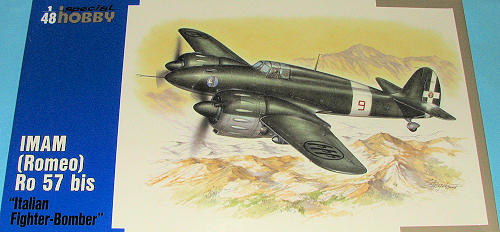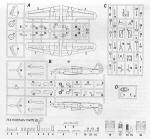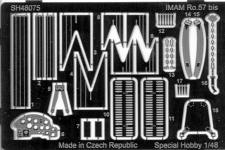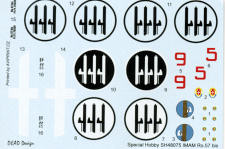
Special Hobby 1/48 IMAM Ro 57bis
| KIT #: | 48075 |
| PRICE: | $48.25 from www.greatmodels.com |
| DECALS: | Three options |
| REVIEWER: | Scott Van Aken |
| NOTES: | Short run with photo etch and resin parts |

| HISTORY |
The Ro.57 was preceded by another twin engine fighter design, the Ro.53, which never entered production. The Ro.57 consisted of an all-metal, semi-monocoque fuselage with a steel skeleton and Duralumin structure. The wings were also Duralumin.
Powered by two 840 hp (630 kW) Fiat A.74 radial engines giving a maximum speed of 516 km/h, which in 1939 was better than that of the main Italian fighter, the Macchi C.200 (504 km/h). After testing at Guidonia it was proposed by IMAM for use as a dive bomber. This transformation, which involved the addition of dive brakes, provision for 500 kg bombs and an improved forward firing armament (adding two 20 mm cannon), took time and delayed production. The resulting aircraft was designated the Ro.57bis. Performance dropped to 457 km/h maximum speed and to 350 km/h at cruise speed. The Ro.57bis was ordered into production in 1942 and entered service with the 97° Gruppo in 1943. About 50-60 aircraft were delivered.
It is said that the Ro.57 could have been the long range interceptor that Italy lacked throughout the war. It proved to be too costly for the limited weapons it carried and it never was assigned a clear role. A better-armed version with more powerful engines was developed as the Ro.58.
| THE KIT |
 Typical
of today's MPM/Special Hobby/Azur kit, this one is very nicely molded with
engraved panel lines and relies on resin and photo etch for a lot of the detail
parts. Resin is used for the engine cowlings, engines, a few intakes and scoops
as well as bomb rack holders to name a few. The engines are built up from a
central block and 14 separate cylinders each. Photo etch is used for much of th
Typical
of today's MPM/Special Hobby/Azur kit, this one is very nicely molded with
engraved panel lines and relies on resin and photo etch for a lot of the detail
parts. Resin is used for the engine cowlings, engines, a few intakes and scoops
as well as bomb rack holders to name a few. The engines are built up from a
central block and 14 separate cylinders each. Photo etch is used for much of th e
interior detailing such as knobs, instrument panel, harness, bomb fins and a few
other smaller items.
e
interior detailing such as knobs, instrument panel, harness, bomb fins and a few
other smaller items.
The three injected sprues contain most of the rest of
the airframe pieces. It also includes many of the pieces for the cockpit
including the floor, seat and additional framework onto which the resin control
boxes are attached. This is all trapped between the fuselage halves during
construction. The kit requires the wheel wells to be made up of separate bits
before being surrounded by the engine nacelle sections. There is a firewall on
which to attach the engines. Bombs will need to be constructed and one will need
to anneal the etch as the circular fins are photo etch pieces. No direct
location for the bomb racks is molded on the lower wings, but Special
 Hobby does
provide distance information so these items can be properly placed. The main
gear legs look to be a tad fussy, but should be very strong once the cement has
dried.
Hobby does
provide distance information so these items can be properly placed. The main
gear legs look to be a tad fussy, but should be very strong once the cement has
dried.
Markings are provided for three planes all with dark green over light grey camouflage with white bands around the fuselage. Two are with the 97th Autonomous Group in the Rome area during July 1943 while a third is based at Naples in 1943. The decal sheet is very nicely done and should provide no problems. Instructions are typical Special Hobby with nicely drawn construction steps and some detail images so you can be sure you glued everything properly.
| CONCLUSIONS |
Not your usual Italian subject, but a nice looking kit that should make into an equally nice looking model. For sure, you won't find this one being done by Hasegawa!
| REFERENCES |
http://en.wikipedia.org/wiki/IMAM_Ro.57
July 2011 I got this at
www.greatmodels.com where you can find this kit and many other fine kits and
accessories. If you would like your product reviewed fairly and fairly quickly, please contact the editor or see other details in the Note to
Contributors.